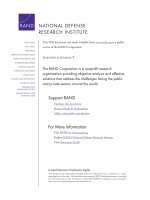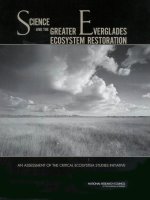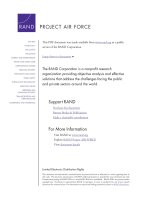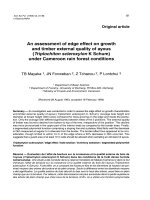An assessment of coping mechanisms and passage of leisure time the case of pensioned older people in gulele sub city
Bạn đang xem bản rút gọn của tài liệu. Xem và tải ngay bản đầy đủ của tài liệu tại đây (904 KB, 113 trang )
RUNNING HEAD: AN ASSESSMENT OF COPING MECHANISMS…
AN ASSESSMENT OF COPING MECHANISMS AND PASSAGE OF LEISURE TIME:
THE CASE OF PENSIONED OLDER PEOPLE IN GULELE SUB-CITY
By: Maaza Araya
A Thesis Submitted to School of Social Work, Addis Ababa University Presented in Partial
Fulfillment of the Requirements for the Degree of Master Social Work
Addis Ababa University
Addis Ababa Ethiopia
June, 2017
AN ASSESSMENT OF COPING MECHANISMS
AN ASSESSMENT OF COPING MECHANISMS AND PASSAGE OF LEISURE TIME:
THE CASE OF PENSIONED OLDER PEOPLE IN GULELE SUB-CITY
By: Maaza Araya
Advisor: Messay G/Mariam (PhD)
A Thesis Submitted to School of Social Work, Addis Ababa University Presented in Partial
Fulfillment of the Requirements for the Degree of Master of Social Work
Addis Ababa University
Addis Ababa Ethiopia
June, 2017
AN ASSESSMENT OF COPING MECHANISMS
DECLARATION
This is to certify that the thesis prepared by Maaza Araya entitled: An assessment of coping
mechanisms and passage of leisure time: the case of pensioned older people in Gulele subcity submitted in partial fulfillment of the requirements for the degree of Master of Social Work
complies with the regulation of the university and meets the accepted standards with respect to
originality and quality.
Approved by examining board
___________________________________
Name, Internal Examiner
___________________________________
Name External Examiner
___________________________________
Name Advisor
_______________________
_____________
Signature
_______________________
Date
_____________
Signature
Date
_______________________
_____________
Signature
Date
___________________________________________________
Chair man of Department or Graduate Program Coordinator
AN ASSESSMENT OF COPING MECHANISMS
Declaration
I declare thatAn assessment of survival mechanisms and passage of leisure time: the case of
pensioned older people in Gulele sub-city is my own work. All the sources that I have used or
quoted have been indicated. I have acknowledged by means of reference and that this work has
not been submitted before any others degree at any other institution.
Maaza Araya G/Michael
Signature: ___________________________
Date: _______________________________
Place: Addis Ababa University, Ethiopia
AN ASSESSMENT OF COPING MECHANISMS…
Abstract
In Ethiopia little attempts are made to study about elderly. Thus, this research is intended to
explore the coping mechanisms and leisure time passage of pensioned elderly in Gulele-sub-city.
The study used exploratory qualitative case study design. Research participants were selected via
non-probability purposive sampling technique and data was collected through the use of an indepth interview, FGD, observation and document review. Data was analyzed by usingthematic
analysis. The study findings indicated that income from pension is unsatisfactory to live with as a
result the elderly engaged in different post-retirement and income generating activities for their
survival. Moreover, informal support system has significant relevance for them. Looking to their
leisure time activity there are no such facilities in the study area where they feel forgotten as a
result. The study will have relevance for different stakeholders such as government to improve
services provided for the elderly in relation to income, incentives and establishing leisure time
facilities appropriate for the elderly.
Key words, Elderly, Pensioned, coping, Leisure
i
AN ASSESSMENT OF COPING MECHANISMS…
Acknowledgement
I thank God for seeing me through this crucial phase of my life, which was both
demanding and interesting. This study was only possible with the support and contributions of
several individuals.
I would like to express my sincere gratitude to my thesis supervisor, Dr. Messay
G/Mariam forhis valuable comments that heprovided me, his support, encouragement and
guidance. I appreciate your courage and willingness to guide me through this study. My gratitude
also goes to Dr. AshenafiHagos for his kindly support.
My thesis also could not be true without the participation and support of the research
participants (Pensioned elderly persons) and government officials.
I wish to thank my husband, Sami for being patient and supportive all through this study.
I thank my Mom, Hariya and my sister, Rahwa (my life) for your prayers which have brought me
this far. Most especially, I thank my Dad who always is my teacher and gave me strength,
mentor, encouragement and support. I would also want to thank my friends for being true friends
(Temesgen Lencha, HundieTakele&MahletEndalku) and my sister in- law Fannafor their
support provided me in editing and emotionally
This thesis is dedicated to my two sons Hiyaw and Aaron who are my inspiration and
support whenever I feel weak. And, for the time taken from them .I love you so much.
ii
AN ASSESSMENT OF COPING MECHANISMS…
Table of Contents
Contents
Pages
Abstract ............................................................................................................................................ i
Acknowledgement .......................................................................................................................... ii
Table of Contents ........................................................................................................................... iii
Acronym and abbreviation ............................................................................................................ vii
Chapter one ..................................................................................................................................... 1
1.1 Introduction ........................................................................................................................... 1
1.2 Background of the study ....................................................................................................... 1
1.3 Statement of the problem ...................................................................................................... 3
1.4 Objective of the study ........................................................................................................... 6
1.4.1 General objective ............................................................................................................ 6
1.4.2 Specific objectives .......................................................................................................... 6
1.5 Research questions ................................................................................................................ 6
1.6 Scope of the study ................................................................................................................. 7
1.7 Significance of the study ....................................................................................................... 7
1.8 Operational definitions .......................................................................................................... 8
Chapter two ..................................................................................................................................... 9
2. Literature review ......................................................................................................................... 9
2.1
Introduction ...................................................................................................................... 9
2.2 Definition of elderly .............................................................................................................. 9
2.3 Perceptions about old age .................................................................................................... 10
2.4 Types of pension plans ........................................................................................................ 12
2.4.1 Pension in Ethiopia ....................................................................................................... 13
iii
AN ASSESSMENT OF COPING MECHANISMS…
2.4.1 .1 Pension Rights in Ethiopia ....................................................................................... 13
2.5 Aging and income ............................................................................................................... 13
2.6 Support systems of elderly persons ..................................................................................... 15
2.7Leisure time passage of elderly ............................................................................................ 16
2.8 Community engagement of older persons ........................................................................... 17
2.9Post retirement jobs .............................................................................................................. 18
2.10 Theories of aging ............................................................................................................... 18
2.10.1 Disengagement theory ................................................................................................ 18
2.10.2 Continuity theory ........................................................................................................ 19
2.10.3 Activity theory ............................................................................................................ 20
2.11 National Policies related to elderly and pension ............................................................... 21
2.11.1. National Policies on elderly....................................................................................... 21
2.11.1.1 National plan of action on older persons /1998-2007/ ............................................ 21
2.11.2 National social protection policy of Ethiopia; ............................................................ 21
2.12 Chapter Summary.............................................................................................................. 22
Chapter Three................................................................................................................................ 23
3. Research methodology .............................................................................................................. 23
3.1 Introduction ......................................................................................................................... 23
3.2 Research Design .................................................................................................................. 23
3.3 Area of the Study................................................................................................................. 24
3.4 Eligibility criteria ................................................................................................................ 24
3.5 Sample Size and Sampling .................................................................................................. 25
3.6 Method of Data Collection .................................................................................................. 26
3.6.1 Key Informant Interview .............................................................................................. 26
3.6.2 Focus Group Discussion ............................................................................................... 26
iv
AN ASSESSMENT OF COPING MECHANISMS…
3.6.3 Observation ................................................................................................................... 26
3.6.4 In-depth Interview ........................................................................................................ 27
3.7 Data Analysis ...................................................................................................................... 27
3.8 Quality Assurance ............................................................................................................... 28
3.9 Ethical Consideration .......................................................................................................... 29
Chapter Four ................................................................................................................................. 30
4. Data Presentation ...................................................................................................................... 30
4.1 Brief description of research participants............................................................................ 32
4. 2. Current Pensioned Allowance ........................................................................................... 37
4. 3. Coping mechanisms .......................................................................................................... 38
4. 3. 1Poultry ......................................................................................................................... 38
4.3. 2. Vegetable .................................................................................................................... 39
4.4 Post retirement jobs ............................................................................................................. 39
4.4.1Engaging in formal jobs ................................................................................................ 40
4.4.2 Engaging in non-formal jobs ........................................................................................ 40
4.4.3 Barrier for retired persons not to work ......................................................................... 40
4.5 Formal and informal supports ............................................................................................. 41
4.5.1. Supports emerged from various types of relationships ............................................... 42
4.5.2 Community based organization „Idir” .......................................................................... 44
4.6 Engagement of elderly persons ........................................................................................... 44
4.6.1 Community organization .............................................................................................. 45
4.6.1.1. Idir, Iqub and Mahber ............................................................................................... 45
4.6.1.2 Elderly forum ............................................................................................................. 47
4.6.2 Consumer‟s cooperatives .............................................................................................. 47
4.6.3 Elderly associations ...................................................................................................... 48
v
AN ASSESSMENT OF COPING MECHANISMS…
4.6.4 Other participations ...................................................................................................... 49
4.6.4.1 Conflict resolution ..................................................................................................... 49
4.6.4.2 Development activities .............................................................................................. 50
4.6.4.3. Arrangement of Marriage proposals ......................................................................... 50
4.7 Leisure time activities of elderly ......................................................................................... 50
4.7.1 Where the retirees pass most of their day ..................................................................... 50
4.7.1.1 Home ......................................................................................................................... 50
4.7.1.2 Church ....................................................................................................................... 51
4.7.1.3 Reading and movies................................................................................................... 51
4.7.2 With whom they spend most of their time ................................................................... 51
4.7.3 Availability of leisure time facilities / activities ........................................................... 52
4.7.4 Leisure time activities and facilities preferred by elderly ............................................ 53
4.7.5 The benefits of recreation centers or leisure time activities ......................................... 54
4.8 Chapter Summary................................................................................................................ 54
Chapter five ................................................................................................................................... 56
5. Discussion ................................................................................................................................. 56
Chapter six .................................................................................................................................... 66
6. Conclusion and social work implication ................................................................................... 66
6.1 Conclusion........................................................................................................................... 66
6.2 Social work implication ...................................................................................................... 67
6.2.1 Implication for Social work education ......................................................................... 67
6.2.2 Implication for Social work Research .......................................................................... 68
6.2.3 Implication for program and policies ........................................................................... 68
6.2.4 Implication for Social Work Practice ........................................................................... 69
References ...................................................................................................................................... x
vi
AN ASSESSMENT OF COPING MECHANISMS…
Annex
Acronym and abbreviation
AIDS: Acquired immuno deficiency syndrome
CSA: Central Statistics Authority
EEPNA: Ethiopian Elderly Pension National Association
FGD:
Focus group discussion
HIV: Human Immuno Deficiency virus
ILO:
International Labor Organization
MoLSA: Ministry of Labor and Social Security
NGO: Non-Governmental Organization
PSSA: Pension and Social Security Authority
SNNPR: Southern Nations & Nationalities peoples Region
UN: United Nations
WHO: World Health Organization
vii
AN ASSESSMENT OF COPING MECHANISMS…
viii
AN ASSESSMENT OF COPING MECHANISMS…
Chapter one
1.1 Introduction
The purpose of this research paper is to explore the coping mechanisms and passage of
leisure time for the pensioned elderly in Gulele sub-city district 03, 04 and 05. It has six
chapters. In this introductory chapter, the background of the study, the statement of the problem,
the objectives of the study, the scope of the study, significance of the study and operational
meanings in relation to the current study such as definitions of elderly, pensioned, retirees and
leisure time are presented.
1.2 Background of the study
The world population continues to grow older rapidly as fertility rates have fallen to very
low levels in most world regions and people tend to live longer. When the global population
reached 7 billion in 2012, 562 million (or 8.0 percent) were aged 65 and over. In 2015, 3 years
later, the older population rose by 55 million and the proportion of the older population reached
8.5 percent of the total population. From 2025 to 2050, the older population is projected to
almost double to 1.6 billion globally, whereas the total population will grow by just 3.4 percent
over the same period (Wan He, Goodkind, & Kowal, 2016).
It is inevitable that the ageing population of Africa will continue to grow for a number of
decades into the future. The increasing number of ageing people in Africa is a demographic
phenomenon linked to decreases in fertility and mortality and is not merely the consequence of
economic development. Projections suggest that the number of people over the age of 60 will
increase from 64.5 million in 2015 to 103 million in 2030 to 205 million in 2050. These figures
indicate that the growth rate of the elderly population will be exponential (Pillay & Maharaj
2013).
1
AN ASSESSMENT OF COPING MECHANISMS…
In Ethiopia, the 2007 Central Statistical Authority report shows that 3,565,161 (4.8 per
cent) of the total Ethiopian population are 60 years and above. Of these, about 532,093 (14.9 per
cent) live in urban areas, whereas the rest 3,033,068(85.1 per cent) live in rural areas of the
country (Help age, 2013).Aging is taking place alongside other broad social trends that will
affect the lives of older people. Economies are globalizing, people are more likely to live in
cities, and technologies evolving rapidly. Demographic and family changes mean there will be
fewer older people with families to care for them (Global health & aging, 2011).
Population aging generates many challenges and sparks concerns about the pace of future
economic growth, the operation and financial integrity of health care and pension systems, and
the well-being of the elderly. Population aging has implications for various types of pension
systems. Publicly funded pension systems face serious challenges, as the number of beneficiaries
will increase while the number of contributors will decline (Bloom, Boersch-Supan, McGee, &
Seike, 2011).
For most of the world‟s population, the right to income security in old age is unfulfilled,
and considerable inequalities persist. Globally, 42.2 per cent of the working-age population is
currently potentially covered by existing laws that provide for old age pension coverage through
contributory or non-contributory schemes (including voluntary coverage). This population can
therefore be expected to receive an old-age pension once reaching the prescribed age, if these
laws are properly implemented and enforced. In lower-income countries, usually only a very
small proportion of those employed are wage and salary earners with formal employment
contracts, and are thus relatively easily covered by contributory pensions (ILO, 2014).
In response to limited coverage of the contributory pension system, some developing
countries have adopted non-contributory “social” pension schemes to provide a basic income for
2
AN ASSESSMENT OF COPING MECHANISMS…
older persons. The programs differ in the nature and extent of benefits provided as well as in
eligibility criteria. Social pension programs that provide wide coverage and relatively generous
benefits can greatly reduce the risk of poverty in old age. Even when benefit amounts leave some
recipients below the poverty line, such pensions reduce the depth of poverty and can lead to
improved health and nutrition for everyone in the recipient‟s household (UN, 2011)
1.3 Statement of the problem
There are various studies concerning the elderly. Among these, Powel& Khan (2013)
conducted study about aging and globalization. They concluded that changing the age structure
of societies has affected the labor force participation of societies; which is the rise of aged
population globally could threaten productivity and the ability to support aging population. They
also put the need for strong commitment of countries to utilize resources for the wellbeing of
elderly by providing social pensions or restructuring workforce to accommodate older persons at
workplace however, they did not indicate the mechanisms to do so.
AbdSamad & Mansor (2013) in their study population aging and social protection they
addressed that the old age group is getting bigger due to low population growth and increasing
average life span.
Kasiram & Holscher (2015) studied about the challenges and opportunities of the elderly.
They founded that the structural problems experienced by the elderly in S. Africa are poverty,
prevalence of HIV/AIDS, unemployment and crime abound. Due to these structural problems the
elderly are required to care for others such as grandchildren. However, they indicated the need
for further researches in order to generalize.
3
AN ASSESSMENT OF COPING MECHANISMS…
Gutura (2013) studied the impact of old age grant. His finding was that the old age grant
plays vital role for households by contributing significantly to household expenditure.
Likewise Morries (2014) in the study of elderly feminization poverty, analysis of
retirement benefit, health care benefit and elder care giving indicated that women collect less
money in social security benefits, receive smaller pensions and accumulate small private savings
which leaves them with fewer resources upon retirement. The study only focuses on women.
Dhemba (2013) in the study of social protection for the elderly: the issues, challenges and
prospects in Zimbabwe, he indicated that among all other vulnerable groups anti-poverty
measures such as public assistance, pension, other benefits and social welfare programs are
compromised by low coverage for the elderly. And, he concluded that the need for the review of
the old age pension act.
Dahiya, Ashwanti, Shahida Praveen and Hari pal singu (2011) looked about the psychosocial factors affecting the elderly persons. They concluded that old age has not been a problem
in India because of the support and respect for the elderly.
On the other hand, regarding pension, Mudrazija, (2006) in the research entitled pension
system reform theory and empirical study puts pension among the most important social security
programs in the world. And, that mature programs of pension contribute to increased equality
and prevent the elderly from abject poverty. Besides, the size of population receiving pension
benefits relative to working age is increased and the need for pensioned reforms by countries is
addressed.
4
AN ASSESSMENT OF COPING MECHANISMS…
Tiwari ( 2010) also studied the relevance of old age pension in the lives of the
beneficiaries and stated the economic relevance of pension which is enabling and empowering
from economic point of view and socially that it is the independent source of income.
Klumb (1999), studied on the concept of daily activities and survival at old age where he
found consumptive activities were related to survival in persons aged 70 and above.
Letner&Leitner (2012), studied about leisure in letter life by giving emphasis to the
provision of leisure services for elders who are moderately impaired or low functioning. Their
study was intended to provide useful information for leisure service providers.
Similarly, Novak &Vute (2013), conducted study about leisure time activities for women
over the age of 65with the aim of determining their preferred activities. According to their
finding women dedicate most of their time to gardening, watching T.V, reading and meeting
with relatives and friends while their activities related to sport included hiking, walk, cycling
and general exercise.
Ayana (2012) in his study of who will take care of the elderly reciprocal relationships
break down, his findings indicated that the reason behind the breakdown of reciprocal
relationship and how the elderly people survive under such circumstance.
Getenet (2015) in his study of aging and retirement among Ethiopia elderly, adjustment
challenges and policy implications draws in to conclusion that the retired elderly have difficulty
in adjusting retirement with reduced income and weakened social ties. He also put implication
for further studies on how the elderly could continue to live and to explore what coping
strategies retires have been using to cope the situation moreover, he proposed the importance of
qualitative forms of data collection.
5
AN ASSESSMENT OF COPING MECHANISMS…
Generally speaking in Ethiopia little attempts are made in the area of elderly persons, and
particularly there are no researches that showed how the pensioned elderly have managed to live
with scarce income and it is also hard to find studies that show where and how the pensioned
elderly people pass their leisure time as the Amharic word of „Turetgana‟ which stereotypically
meaning „true tegna‟ or enough time to sleep has implied.
1.4 Objective of the study
1.4.1 General objective
The general objective of the study is to explore survival mechanisms and leisure time passage of
pensioned elderly persons.
1.4.2 Specific objectives
To assess the economic condition of the pensioned elderly
To explore means of survival for the pensioned elderly
To examine various support systems
To explore how they spent their leisure time
To assess the efforts to engage pensioned elderly persons
1.5 Research questions
This study answered the following questions in order to address the research objectives.
What is the earning from pension schema?
What are the formal and informal cares provided for them?
In what ways do the elderly spend their leisure time?
What are community based activities that pensioned elderly engage?
What are the coping mechanisms of the pensioned older people at times of difficulties?
6
AN ASSESSMENT OF COPING MECHANISMS…
1.6 Scope of the study
The study is delimited to pensioners who live in Gulele sub city district 03, 04, 05 due to
shortage of time and resources. As there are very limited studies conducted in Ethiopia
addressing concerns about the elderly this study only tried to assess the coping mechanisms of
pensioners with low income and tried to explore how the pensioners spent their spare time
though other studies could also assess the significance of various types of pension schemes for
the elderly from the countries context or concepts such as assessing available incentives for the
elderly or others. Moreover, the study focused on the perspective of the pensioners themselves
with only a glimpse assessment of the policy makers such as officials from social security
agency and EEPNA leaders.
1.7 Significance of the study
As all of us will reach late life at a time under normal circumstance, it is every bodies
business to think for the future and one of the ways is through pension thus, the study tried to
answer the coping mechanisms of the pensioned elderly with the little income earned from
pension through efforts made on their own and informal supports provided for them.
Additionally, the study looked how the elderly spent their spare time and their
contributions to the community. Addressing the above mentioned studies partially (as only the
study covers limited area), it could contribute by being a baseline for other detailed studies
moreover; the implication and recommendation of the study could also benefit policy makers as
an input for further actions.
7
AN ASSESSMENT OF COPING MECHANISMS…
1.8 Operational definitions
Elderly: elderly people (aged) are taken as those who have attained a minimum age, generally
60 years,
Formal work: Activities the elderly are engaged in to generate income monthly
Informal work: Activities the elderly are engaged in to generate income on a daily bases
Leisure: Relaxation activities that engage someone during free time when they are in retirement
Pension: a fixed amount, other than wages and salaries, paid at regular intervals to a person in
consideration of past services
Retired: A person who has finished one's active working life and /or above the age of 60 or in
some cases 55
8
AN ASSESSMENT OF COPING MECHANISMS…
Chapter two
2. Literature review
2.1 Introduction
This chapter presents a review of relevant literatures particularly definition of elderly in
different context, the perceptions about elderly in society, activities performed by elderly and
the leisure time facilities and activities provided for senior generations. Relevant theories of
aging are also discussed. This chapter serves as the background for the other chapters as it
provide with knowledge part and previously conducted studies The sources for the reviewed
literatures were books, journal articles, policies and different thesis.
2.2 Definition of elderly
There are many definitional, conceptual and methodological problems in discussing
elderly people. However, elderly people (aged) are taken as those who have attained a minimum
age, generally 60 years, although some international data sets and commentaries may prefer to
use 55 or 65 years Eboiyehi, (2015).
Most developed countries have generally accepted the chronological age of 65years as
the definition of an „older person‟ WHO, (2009). Aging is recognized as a socially constructed
concept, encompassing not only chronological years, but also biological, psychological, sociocultural, and spiritual processes, as well as cultural ethnic and gender differences (Cohen, 2002).
Age can be defined by the social roles one occupies, by a person‟s level of physical ability, by a
subjective assessment of how old one feels, as well as their chronological years Barrett&
(Cantwell, 2007).
9
AN ASSESSMENT OF COPING MECHANISMS…
The term 'elderly' or older person has different meaning in different countries; it is mainly
explained and is related to chronological age, functional age as well as retirement age. According
to the UN definition older persons are those people whose age is 60 years and over. The
definition has gained acceptance in Ethiopian context as it coincides with the country's official
retirement age (MoLSA,2006).
2.3 Perceptions about old age
Age-related stereotypes are often based on beliefs held about the characteristics
associated with older people and ageing, and people‟s perceptions of the position older adults
occupy in society (Lichtenstein, Pruski, Marshall, Blalock, Liu& Plaelke, 2005).
Along with the image of the aged towards themselves the aged have an image of the way
the rest of society perceive them .Aging is judged by different criterion indifferent societies and
the way the aged are perceived or treated varies from society to society (Sijuwade, 2009).
As cited by (Moscovici, 1984, 1988) Löckenh off et al (2009,) social representations
theory the views of old age held within a given culture are a form of shared cultural
representation. They constitute systems of ideas, values, and customs related to old age that is
treated by members of the society as if they were established reality. Perceptions of old age are
multidimensional in nature. It encompasses both positive and negative characteristics (Hummert,
1990) and reflects a mix between accurate depictions of age-related changes and distorted views
of older people (Kite, Stockdale, Whitley, & Johnson, 2005).
Ageing focus on three perspectives, and these are negative: the topic itself is classified as
really “not interesting”; secondly, ageing is considered as time to suffer for those considered as
old and, thirdly, since older persons are thought to be people with “nothing tangible to do in life”
10
AN ASSESSMENT OF COPING MECHANISMS…
then what they do best is engage in witchcraft - at least from the African perspective and
especially for older women.
However, while there are predominant negativity perceptions exists much to the
detriment and dignity of the aged, other different and quite interesting views are also prominent.
Some sections of society seem to express great interest in discussing and proposing possible
solutions to problems aged per-sons are facing and also pilot to create awareness about issues on
ageing to improve their livelihoods and coexistence in society. However, such efforts are often
hindered by lack of the means to do so (Mapoma & Masaiti,2012, pp. 109).
In some cases young people describe senior citizens, elderly men, and elderly women as
„„sickly,‟‟ „„fragile, ‟marginalized,‟‟ „„not socially valued,‟‟ and „„dependent.‟‟ These images can
be related to the idea of loss of physical vitality „„fragile, dependent,‟‟ „sickly‟‟) and to the
impression of a progressive relegation from society („„marginalized,‟‟ „„not socially valued‟‟).In
respect to the „„healthy/sickly‟‟, although in general senior citizens, elderly men, and elderly
women are perceived as sickly people, mostly elderly men are the worse addressed (Cathalifaud,
2008 pp 113).
In traditional African society, the aged are respected as they are perceived to be the
mediators between this world and the next, the representatives of the ancestors and creators and
the guardians of the cultural traditions. This belief made people cater for them and hold them in
high esteem. Africans believe that old age was an ancestral blessings bestowed on those who live
righteously. It is thus culturally acceptable that the aged who are unable to defend for them must
be catered for by the young if they (the young ones) expect to grow old. Thus, the ability of the
aged persons to cope with changes in health, income, social activities depends to a very large
extent on care and support they receive from the young family members.
11
AN ASSESSMENT OF COPING MECHANISMS…
It was not amazing that children take care of their aged parents no matter what their
perceptions and feelings towards the latter may be (Eboiyeh,2015).
In what we could call a “Pan-Ethiopian” culture, older people are most commonly seen as
wise, worthy of carrying responsibility, resolvers of conflicts (peace makers), community
advisers, persons with great experience and authority (seasoned in specific expertise), and a lot
more positive traits. What comes to mind when we hear the Amharic word „shimagile‟ (literally,
old man) is often a person who would resolve conflicts and make peace. Accordingly, the
process of resolving conflicts through arbitration have come to be called „shimgilina‟ similar
difference is also given to older women (Help Age, 2013 pp 5-6).
While in almost all Ethiopian communities older women play significant role as
traditional birth attendants and advisers on child-raising, there are many localities where older
women take part in conflict resolution, too (Help Age,2013 pp 5-6).
2.4 Types of pension plans
Pension plan: a pension (or retirement income) plan (arrangement or scheme) is a legally
binding contract having an explicit retirement objective (or - in order to satisfy tax related
conditions or contract provisions - the benefits cannot be paid at all or without a significant
penalty unless the beneficiary is older than a legally defined retirement age (Yermo,2002 pp 3).
There are four types of pensions in Sub-Saharan Africa: (i) non-contributory pensions or
transfers in old-age assistance which may be universal, pensions-tested or otherwise meanstested(Zero Pillar); (ii) mandatory contributory pension schemes (1st or 2nd pillar); (iii)
voluntary, regulated occupational or personal pension savings and insurance arrangements (3rd
pillar); and (iv) other informal voluntary savings arrangements and household assets, savings or
transfers to support the elderly (4th pillar). Under this typology, civil service pension schemes
12
AN ASSESSMENT OF COPING MECHANISMS…
are classified under occupational-pension schemes even though many such schemes in sub
Saharan Africa are non-contributory. Contributory schemes may be entirely pay-as-you-go with
contributions financing benefits; partially funded with some reserve accumulations; or fully (pre)
funded with funds set aside for all pension liabilities (Dorfman,2015).
2.4.1 Pension in Ethiopia
The prevailing type of security system in Ethiopia is the government sponsored Social
Security system. Formal social security system in Ethiopia dates back to the formulation of the
Pension and Social Security Authority (PSSA) in 1963 (Pubic Service Pension, Proclamation N.
209/1963). This decree covered only the military and civil service workers. Only government
employees were covered and large portion who were employed in the informal sector, the private
sector or is self-employed excluded until the current decree (Kokobe,2015 pp 2-6).
2.4.1 .1 Pension Rights in Ethiopia
Law provides for both full and early pension. For full pension, a worker must have
attained 60 years of age (same for women) with at least 120 months (10 years) of contributions.
Early pension is available for workers who have attained 55 years of age with at least 300
months (25 years) of contributions and 45 to 55 years of age (depending on rank), in military,
with at least 10 years of service and contribution ( Pension Proclamation No. 715/2011)
2.5 Aging and income
Older people are consistently among the poorest in all societies, and material security is
therefore one of the greatest preoccupations of old age (Kalassa,2005 pp. 7).The retirement
benefit given to employees at retirement is inadequate in the face of the present market situation
thus; Employees and retirees should be encouraged to invest in assets and financial instruments
13









